Spring MVC整合Mybatis 入门
本文记录使用Intellij创建Maven Web工程搭建Spring MVC + Mybatis 的一个非常简单的示例。关于Mybatis的入门使用可参考这篇文章,本文在该文的基础上,引入了Spring MVC功能。 首先是创建项目:
打开Intellij,File-->new Project--->选中,Maven--->勾上"Create from archetype"--->选择 Maven web project。如下图:
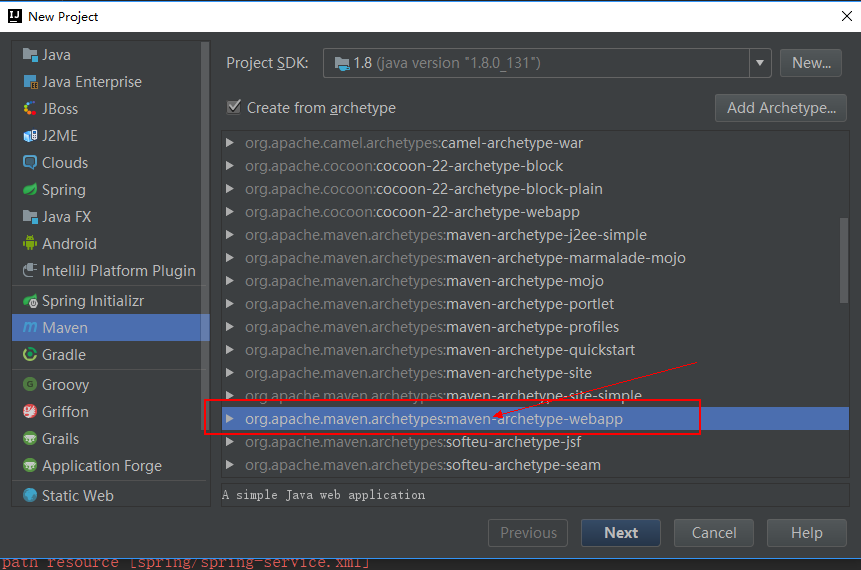
一步步Next,等待工程Build成功,如果右下角有提示“Maven project need to be imported“则点击: import change...”
完了之后,整个项目Build Success,会生成如下初始目录:
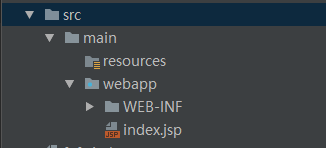
在src.main下新建一个文件夹 java, 作为源代码目录。CTRL+ALT+SHIFT+S 打开“project structure配置窗口”,将 java 目录关联成 source目录。
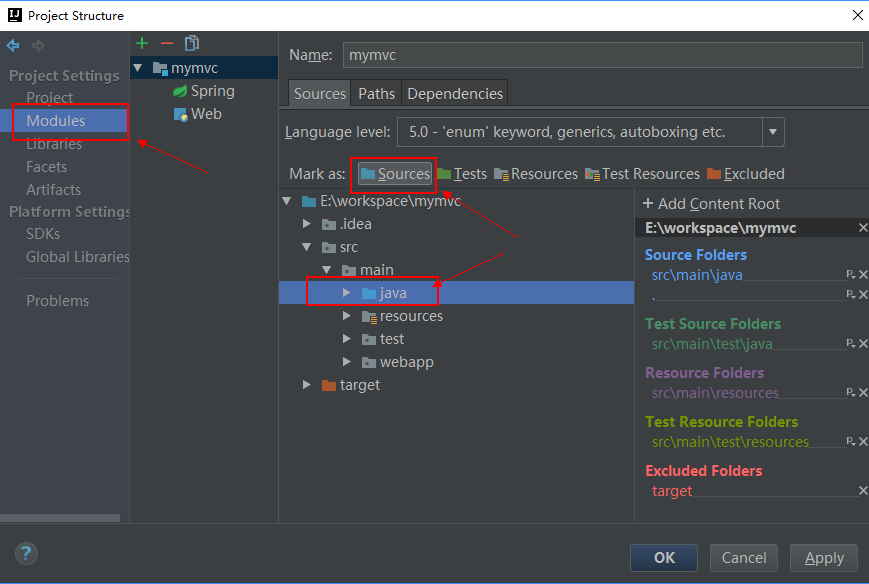
在 java 目录下创建四个子目录 controller、mapper、pojo、service
controller,控制器类。DispatcherServlet将拦截到的HTTP请求交给对应的Controller来处理,Controller调用 Service 完成相应的请求任务。
service,业务逻辑实现类。Service 一般都需要DAO类(或者说Mapper类)操作数据库,然后完成相应的业务逻辑处理。
mapper,数据库操作类。定义了一些如何操作数据库的方法。
pojo,实体类。对应数据库中的表,一般pojo类中的每个属性对应数据库中的一个字段。
此外,还有配置文件目录。在 src/main/resources目录下,新建mapper文件夹,与 src/main/java/mapper 对应:一个RoleMapper.java 对应着一个 RoleMapper.xml配置文件,再加上相应的Spring配置就可以实现数据库的操作。在 src/main/resources目录下,新建spring文件夹,里面有三个配置文件:spring-web.xml是web相关配置;spring-dao.xml是数据库相关的配置;spring-service.xml是Service类相关的配置。当然也可以将所有的配置放在一个文件里,比如常见的applicationContext.xml,分开配置的话,可能看起来更清晰。 大致目录结构如下:
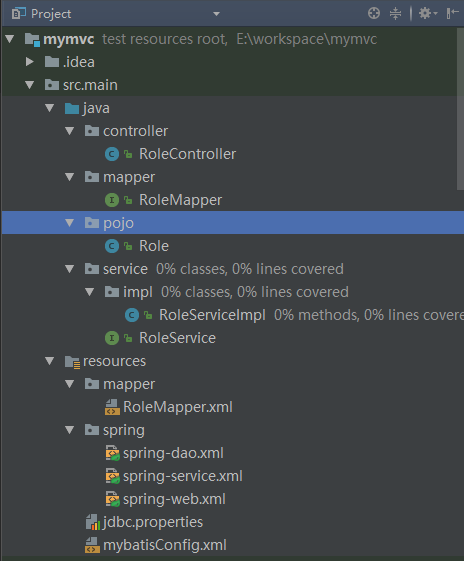
POJO类 Role.java代码和数据库表t_role字段,参考这篇文章前面部分。RoleMapper.java 定义了操作数据库的方法--根据 id字段 来查找 Role,getRole方法配合RoleMapper.xml中定义的数据库操作语句,就可以由Mybatis框架来负责所有的数据库操作事宜了。代码 如下:
package mapper;
import org.springframework.stereotype.Repository;
import pojo.Role;
@Repository
public interface RoleMapper {
public Role getRole(long id);
}
对应的RoleMapper.xml配置如下:
<?xml version="1.0" encoding="UTF-8"?>
<!DOCTYPE mapper PUBLIC "-//mybatis.org//DTD Mapper 3.0//EN"
"http://mybatis.org/dtd/mybatis-3-mapper.dtd">
<mapper namespace="mapper.RoleMapper">
<select id="getRole" parameterType="long" resultType="Role">
select id,
role_name as roleName, note from t_role where id = #{id}
</select>
</mapper>
再来看业务逻辑,很简单:用户从浏览器中发一个查询请求 Role,请求的参数为 id,Service根据 id 去数据库找 Role 记录,返回给用户 id 对应的Role。
RoleService.java代码如下:
package service;
import pojo.Role;
/**
* Created by Administrator on 2017/8/10.
*/
public interface RoleService {
public Role getRole(long id);
}
具体的实现类如下:
1 package service.impl;
2
3 import mapper.RoleMapper;
4 import org.springframework.beans.factory.annotation.Autowired;
5 import org.springframework.stereotype.Service;
6 import pojo.Role;
7 import service.RoleService;
8
9 /**
10 * Created by Administrator on 2017/8/10.
11 */
12 @Service
13 public class RoleServiceImpl implements RoleService {
14
15 @Autowired
16 private RoleMapper roleMapper;
17
18 public Role getRole(long id){
19 Role role = roleMapper.getRole(id);
20 return role;
21 }
22 }
第12行, @Service 以Spring注解的方式将RoleServiceImpl定义成Bean,在spring-service.xml中配置:component-scan,让Spring去扫描 service包下带有注解的类,告诉Spring容器 RoleService(Impl)类 是一个Bean对象。在其它类中就可以用 @Autowired 将RoleService注入。
<!-- 扫描service包下所有使用注解的类型 -->
<context:component-scan base-package="service" />
完整spring-sevice.xml配置文件:

<?xml version="1.0" encoding="UTF-8"?>
<beans xmlns="http://www.springframework.org/schema/beans"
xmlns:xsi="http://www.w3.org/2001/XMLSchema-instance"
xmlns:context="http://www.springframework.org/schema/context"
xmlns:tx="http://www.springframework.org/schema/tx"
xsi:schemaLocation="http://www.springframework.org/schema/beans
http://www.springframework.org/schema/beans/spring-beans.xsd
http://www.springframework.org/schema/context
http://www.springframework.org/schema/context/spring-context.xsd
http://www.springframework.org/schema/tx
http://www.springframework.org/schema/tx/spring-tx.xsd">
<!-- 扫描service包下所有使用注解的类型 -->
<context:component-scan base-package="service" />
<import resource="spring-dao.xml"/>
<!-- 配置事务管理器 -->
<bean id="transactionManager"
class="org.springframework.jdbc.datasource.DataSourceTransactionManager">
<!-- 注入数据库连接池 -->
<property name="dataSource" ref="dataSource" />
</bean>
<!-- 配置基于注解的声明式事务 -->
<tx:annotation-driven transaction-manager="transactionManager" />
</beans>
RoleController.java代码如下:
1 package controller;
2
3 import org.springframework.beans.factory.annotation.Autowired;
4 import org.springframework.stereotype.Controller;
5 import org.springframework.web.bind.annotation.RequestMapping;
6 import org.springframework.web.bind.annotation.RequestParam;
7 import org.springframework.web.bind.annotation.ResponseBody;
8 import pojo.Role;
9 import service.RoleService;
10
11 /**
12 * Created by Administrator on 2017/8/10.
13 */
14 @Controller
15 public class RoleController {
16 @Autowired
17 private RoleService roleService;
18
19 @RequestMapping("/role/getRole")
20 @ResponseBody public Role getRole(@RequestParam("id") long id)
21 {
22 long start = System.currentTimeMillis();
23 Role role = roleService.getRole(id);
24 long end = System.currentTimeMillis();
25 System.out.println(end-start);
26 return role;
27 }
28 }
14行,@Controller 以Spring注解的方式将 RoleController类定义为Spring容器可管理的Bean。
19行,在web.xml中配置了 servlet-mapping,当浏览器请求的URL带有" role/getRole "时,就会拦截请求将给 RoleController来处理。
20行,@ResponseBody定义了 处理之后的返回值,将 Role 对象以 JSON格式封装起来,返回给浏览器。@RequestParam("id"),定义请求参数。
比如在浏览器中输入:http://localhost:8000/mvc /role/getRole ?id=5

数据库中记录如下:
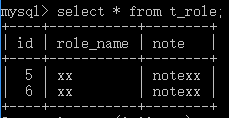
这一切到底是如何得到的呢?
①RoleController需要一个RoleService对象,然后在第23行调用 getRole方法,返回一个Role对象。首先第16-17行,使用 @Autowired将 RoleService注入到RoleController中,这样RoleController不需要显示地new RoleService对象,对应的创建过程由Spring容器自动完成----对象的创建 与 “对象的使用” 解耦。“对象的使用其实就是业务逻辑,让开发者不需要关注对象的创建了”
②为什么Spring容器知道 将 RoleService 作为一个Bean注入到 RoleController中去呢?
因为,RoleService类使用 了@Service 注解,并且在spring-service.xml中配置 了<component-scan....> 见上面RoleService源代码部分。
③为什么 roleSevice.getRole(id)就能从数据库中查找相应的记录并返回呢?前面的RoleMapper.java 和 RoleMapper.xml配置文件已经定义好了操作数据库的语句:
select id,role_name as roleName, note from t_role where id = #{id}
然后我们又在spring-dao.xml中配置了访问数据库:详细具体解释如下:
<context:component-scan base-package="mapper"/>
告诉Spring容器扫描mapper目录下的 带注解的类,这样RoleService就可以自动注入 RoleMapper对象了,有了RoleMapper对象,通过Mybatis框架,就可以访问数据库了。而Spring与Mybatis的整合依赖包,就需要在pom.xml中给出:
<dependency>
<groupId>org.mybatis</groupId>
<artifactId>mybatis-spring</artifactId>
<version>1.3.0</version>
</dependency>
<dependency>
<groupId>org.mybatis</groupId>
<artifactId>mybatis</artifactId>
<version>3.4.0</version>
</dependency>
<context:property-placeholder location="classpath:jdbc.properties"/>
配置数据库连接信息:访问哪个数据库?数据库地址在哪?访问数据库的端口是什么?用户名和密码是什么?这些信息都在jdbc.properties文件中定义好了,<context:property-placeholder>告诉Spring容器去哪里读取jdbc.properties配置文件。jdbc.properties文件如下:
jdbc.driver=com.mysql.jdbc.Driver jdbc.url=jdbc:mysql://localhost:3306/test jdbc.username=root jdbc.password=xxxxx
知道了数据库在哪里了,以何种方式连接数据库呢?一般会配置各种连接池
<!-- 2.数据库连接池 -->
<bean id="dataSource" class="com.mchange.v2.c3p0.ComboPooledDataSource">
<!-- 配置连接池属性 -->
<property name="driverClass" value="${jdbc.driver}"/>
<property name="jdbcUrl" value="${jdbc.url}"/>
<property name="user" value="${jdbc.username}"/>
<property name="password" value="${jdbc.password}"/>
<!-- c3p0连接池的私有属性 -->
<property name="maxPoolSize" value="30"/>
<property name="minPoolSize" value="10"/>
<!-- 关闭连接后不自动commit -->
<property name="autoCommitOnClose" value="false"/>
<!-- 获取连接超时时间 -->
<property name="checkoutTimeout" value="10000"/>
<!-- 当获取连接失败重试次数 -->
<property name="acquireRetryAttempts" value="2"/>
</bean>
连接池的依赖包,又在哪里呢?因为我们使用的是Maven POM管理依赖,在pom.xml文件中就需要配置:
<dependency>
<groupId>mysql</groupId>
<artifactId>mysql-connector-java</artifactId>
<version>5.1.37</version>
<scope>runtime</scope>
</dependency>
<dependency>
<groupId>c3p0</groupId>
<artifactId>c3p0</artifactId>
<version>0.9.1.2</version>
</dependency>
配置好了访问数据库的环境,还需要访问数据库的具体实例,这就是SqlSession。于是继续在spring-dao.xml添加配置:
<!-- 3.配置SqlSessionFactory对象 -->
<bean id="sqlSessionFactory" class="org.mybatis.spring.SqlSessionFactoryBean">
<!-- 注入数据库连接池 -->
<property name="dataSource" ref="dataSource"/>
<!-- 配置MyBaties全局配置文件:mybatisConfig.xml -->
<property name="configLocation" value="classpath:mybatisConfig.xml"/>
<!-- 扫描entity包 使用别名 -->
<property name="typeAliasesPackage" value="pojo"/>
<!-- 扫描sql配置文件:mapper需要的xml文件 -->
<property name="mapperLocations" value="classpath:mapper/*.xml"/>
</bean>
接下来再把SqlSession 告诉RoleMapper对象,让它拿着SqlSession去操作数据库。
<!-- 4.配置扫描Dao接口包,动态实现Dao接口,注入到spring容器中 -->
<bean class="org.mybatis.spring.mapper.MapperScannerConfigurer">
<!-- 注入sqlSessionFactory -->
<property name="sqlSessionFactoryBeanName" value="sqlSessionFactory"/>
<!-- 给出需要扫描mapper接口包 -->
<property name="basePackage" value="mapper"/>
</bean>
因此,这也是为什么 我们只需要通过Spring将RoleMapper能够访问数据库的原因。而当 Service需要访问数据库时,只需要将RoleMapper注入进来,就可以执行getRole方法查询数据库了。
完整的spring-dao.xml配置文件:

<?xml version="1.0" encoding="UTF-8"?>
<beans xmlns="http://www.springframework.org/schema/beans"
xmlns:xsi="http://www.w3.org/2001/XMLSchema-instance"
xmlns:context="http://www.springframework.org/schema/context"
xsi:schemaLocation="http://www.springframework.org/schema/beans
http://www.springframework.org/schema/beans/spring-beans.xsd
http://www.springframework.org/schema/context
http://www.springframework.org/schema/context/spring-context.xsd">
<context:component-scan base-package="mapper"/>
<!-- 配置整合mybatis过程 -->
<!-- 1.配置数据库相关参数properties的属性:${url} -->
<context:property-placeholder location="classpath:jdbc.properties"/>
<!-- 2.数据库连接池 -->
<bean id="dataSource" class="com.mchange.v2.c3p0.ComboPooledDataSource">
<!-- 配置连接池属性 -->
<property name="driverClass" value="${jdbc.driver}"/>
<property name="jdbcUrl" value="${jdbc.url}"/>
<property name="user" value="${jdbc.username}"/>
<property name="password" value="${jdbc.password}"/>
<!-- c3p0连接池的私有属性 -->
<property name="maxPoolSize" value="30"/>
<property name="minPoolSize" value="10"/>
<!-- 关闭连接后不自动commit -->
<property name="autoCommitOnClose" value="false"/>
<!-- 获取连接超时时间 -->
<property name="checkoutTimeout" value="10000"/>
<!-- 当获取连接失败重试次数 -->
<property name="acquireRetryAttempts" value="2"/>
</bean>
<!-- 3.配置SqlSessionFactory对象 -->
<bean id="sqlSessionFactory" class="org.mybatis.spring.SqlSessionFactoryBean">
<!-- 注入数据库连接池 -->
<property name="dataSource" ref="dataSource"/>
<!-- 配置MyBaties全局配置文件:mybatisConfig.xml -->
<property name="configLocation" value="classpath:mybatisConfig.xml"/>
<!-- 扫描entity包 使用别名 -->
<property name="typeAliasesPackage" value="pojo"/>
<!-- 扫描sql配置文件:mapper需要的xml文件 -->
<property name="mapperLocations" value="classpath:mapper/*.xml"/>
</bean>
<!-- 4.配置扫描Dao接口包,动态实现Dao接口,注入到spring容器中 -->
<bean class="org.mybatis.spring.mapper.MapperScannerConfigurer">
<!-- 注入sqlSessionFactory -->
<property name="sqlSessionFactoryBeanName" value="sqlSessionFactory"/>
<!-- 给出需要扫描Dao接口包 -->
<property name="basePackage" value="mapper"/>
</bean>
</beans>
前面介绍的都是Spring应用上下文,而这里的 HTTP请求牵涉到 web应用上下文,二者是如何结合的呢?在web.xml中进行配置:
<servlet>
<servlet-name>mvc</servlet-name>
<servlet-class>org.springframework.web.servlet.DispatcherServlet</servlet-class>
<!-- 配置springMVC需要加载的配置文件
spring-dao.xml,spring-service.xml,spring-web.xml
Mybatis - > spring -> springmvc
-->
<init-param>
<param-name>contextConfigLocation</param-name>
<param-value>classpath:spring/spring-*.xml</param-value>
</init-param>
</servlet>
通过contextConfigLocation将 spring上下文中的配置文件加载进来,实现二者的结合。
发起请求--->请求拦截--->返回请求 是如何实现的呢?在web.xml中配置了servlet-mapping,其中的<servlet-name> mvc </servlet-name>这也是请求URL中 有 mvc 前缀的原因。<url-pattern>将匹配的请求交给DispatcherServlet,由DispatcherServlet转发给相应的 Controller,在RoleController.java中使用 @RequestMapping配置了 请求的路径 role/getRole ,这样 http://localhost:8000/ mvc / role/getRole ?id=5 就会交给RoleController来处理了。
最后,还需要启动web应用程序,在 pom.xml中配置 jetty 容器,来运行web应用:
<!-- jetty插件 -->
<plugin>
<groupId>org.mortbay.jetty</groupId>
<artifactId>maven-jetty-plugin</artifactId>
<version>6.1.25</version>
<configuration>
<connectors>
<connector implementation="org.mortbay.jetty.nio.SelectChannelConnector">
<port>8000</port>
<maxIdleTime>60000</maxIdleTime>
</connector>
</connectors>
<contextPath>/mvc</contextPath>
<scanIntervalSeconds>0</scanIntervalSeconds>
</configuration>
</plugin>
就可以在IDEA右侧,maven project中点击 jetty run 来运行了。
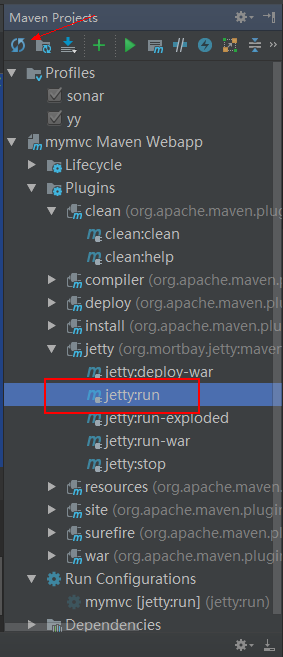
附完整的:mybatisConfig.xml
<?xml version="1.0" encoding="UTF-8" ?>
<!DOCTYPE configuration
PUBLIC "-//mybatis.org//DTD Config 3.0//EN"
"http://mybatis.org/dtd/mybatis-3-config.dtd">
<configuration>
<!-- 配置全局属性 -->
<settings>
<!-- 使用jdbc的getGeneratedKeys获取数据库自增主键值 -->
<setting name="useGeneratedKeys" value="true" />
<!-- 使用列别名替换列名 默认:true -->
<setting name="useColumnLabel" value="true" />
<!-- 开启驼峰命名转换:Table{create_time} -> Entity{createTime} -->
<setting name="mapUnderscoreToCamelCase" value="true" />
</settings>
</configuration>
spring-web.xml
<?xml version="1.0" encoding="UTF-8"?>
<beans xmlns="http://www.springframework.org/schema/beans"
xmlns:xsi="http://www.w3.org/2001/XMLSchema-instance"
xmlns:context="http://www.springframework.org/schema/context"
xmlns:mvc="http://www.springframework.org/schema/mvc"
xsi:schemaLocation="http://www.springframework.org/schema/beans
http://www.springframework.org/schema/beans/spring-beans.xsd
http://www.springframework.org/schema/context
http://www.springframework.org/schema/context/spring-context.xsd
http://www.springframework.org/schema/mvc
http://www.springframework.org/schema/mvc/spring-mvc-3.0.xsd">
<mvc:annotation-driven />
<mvc:default-servlet-handler/>
<!-- 3.配置jsp 显示ViewResolver -->
<!--<bean class="org.springframework.web.servlet.view.InternalResourceViewResolver">-->
<!--<property name="viewClass" value="org.springframework.web.servlet.view.JstlView" />-->
<!--<property name="prefix" value="/WEB-INF/jsp/" />-->
<!--<property name="suffix" value=".jsp" />-->
<!--</bean>-->
<!-- 4.扫描web相关的bean -->
<context:component-scan base-package="controller" />
</beans>
pom.xml配置文件
<project xmlns="http://maven.apache.org/POM/4.0.0" xmlns:xsi="http://www.w3.org/2001/XMLSchema-instance"
xsi:schemaLocation="http://maven.apache.org/POM/4.0.0 http://maven.apache.org/maven-v4_0_0.xsd">
<modelVersion>4.0.0</modelVersion>
<groupId>mymvc</groupId>
<artifactId>mymvc</artifactId>
<packaging>war</packaging>
<version>1.0-SNAPSHOT</version>
<name>mymvc Maven Webapp</name>
<url>http://maven.apache.org</url>
<dependencies>
<dependency>
<groupId>junit</groupId>
<artifactId>junit</artifactId>
<version>3.8.1</version>
<scope>test</scope>
</dependency>
<!-- 2.数据库 -->
<dependency>
<groupId>mysql</groupId>
<artifactId>mysql-connector-java</artifactId>
<version>5.1.37</version>
<scope>runtime</scope>
</dependency>
<dependency>
<groupId>c3p0</groupId>
<artifactId>c3p0</artifactId>
<version>0.9.1.2</version>
</dependency>
<dependency>
<groupId>org.mybatis</groupId>
<artifactId>mybatis-spring</artifactId>
<version>1.3.0</version>
</dependency>
<dependency>
<groupId>org.mybatis</groupId>
<artifactId>mybatis</artifactId>
<version>3.4.0</version>
</dependency>
<!-- 3.Servlet web -->
<dependency>
<groupId>taglibs</groupId>
<artifactId>standard</artifactId>
<version>1.1.2</version>
</dependency>
<dependency>
<groupId>jstl</groupId>
<artifactId>jstl</artifactId>
<version>1.2</version>
</dependency>
<dependency>
<groupId>com.fasterxml.jackson.core</groupId>
<artifactId>jackson-databind</artifactId>
<version>2.5.4</version>
</dependency>
<dependency>
<groupId>javax.servlet</groupId>
<artifactId>javax.servlet-api</artifactId>
<version>3.1.0</version>
</dependency>
<!-- 4.Spring -->
<!-- 1)Spring核心 -->
<dependency>
<groupId>org.springframework</groupId>
<artifactId>spring-core</artifactId>
<version>4.2.2.RELEASE</version>
</dependency>
<dependency>
<groupId>org.springframework</groupId>
<artifactId>spring-beans</artifactId>
<version>4.2.2.RELEASE</version>
</dependency>
<dependency>
<groupId>org.springframework</groupId>
<artifactId>spring-context</artifactId>
<version>4.2.2.RELEASE</version>
</dependency>
<!-- 2)Spring DAO层 -->
<dependency>
<groupId>org.springframework</groupId>
<artifactId>spring-jdbc</artifactId>
<version>4.2.2.RELEASE</version>
</dependency>
<dependency>
<groupId>org.springframework</groupId>
<artifactId>spring-tx</artifactId>
<version>4.2.2.RELEASE</version>
</dependency>
<!-- 3)Spring web -->
<dependency>
<groupId>org.springframework</groupId>
<artifactId>spring-web</artifactId>
<version>4.2.2.RELEASE</version>
</dependency>
<dependency>
<groupId>org.springframework</groupId>
<artifactId>spring-webmvc</artifactId>
<version>4.2.2.RELEASE</version>
</dependency>
<!-- 4)Spring test -->
<dependency>
<groupId>org.springframework</groupId>
<artifactId>spring-test</artifactId>
<version>4.2.2.RELEASE</version>
</dependency>
<dependency>
<groupId>org.testng</groupId>
<artifactId>testng</artifactId>
<version>6.8.7</version>
<scope>test</scope>
</dependency>
<dependency>
<groupId>org.mortbay.jetty</groupId>
<artifactId>jsp-2.1</artifactId>
<version>6.0.0</version>
</dependency>
</dependencies>
<build>
<finalName>mymvc</finalName>
<plugins>
<!-- jetty插件 -->
<plugin>
<groupId>org.mortbay.jetty</groupId>
<artifactId>maven-jetty-plugin</artifactId>
<version>6.1.25</version>
<configuration>
<connectors>
<connector implementation="org.mortbay.jetty.nio.SelectChannelConnector">
<port>8000</port>
<maxIdleTime>60000</maxIdleTime>
</connector>
</connectors>
<contextPath>/mvc</contextPath>
<scanIntervalSeconds>0</scanIntervalSeconds>
</configuration>
</plugin>
</plugins>
</build>
</project>
RoleService的调试:
在src目录下,新建 test 文件夹,用来作测试目录。然后在test目录下,建一个java目录,并将该目录关联为 “测试目录”。然后,在java目录下,src/main/java 一 一 对应的文件夹,作为mapper、controller、service类的测试类存放的文件夹。
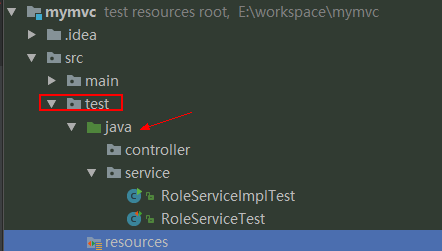
比如,对RoleService进行测试如下:
package service;
import org.springframework.context.ApplicationContext;
import org.springframework.context.support.ClassPathXmlApplicationContext;
import pojo.Role;
/**
* Created by Administrator on 2017/8/12.
*/
public class RoleServiceImplTest {
public static void main(String[] args) {
ApplicationContext applicationContext = new ClassPathXmlApplicationContext("classpath:spring/spring-service.xml");
RoleService roleService = (RoleService) applicationContext.getBean(RoleService.class);
Role role = roleService.getRole(5);
System.out.println(role);
}
}
或者使用 TestNg等测试工具进行测试。
本文永久更新链接地址 : http://www.linuxidc.com/Linux/2017-08/146152.htm
- 本文标签: dependencies struct UI entity 时间 Service java SpringMVC maven 数据库 dataSource IDE ACE 实例 sqlsession 测试 主键值 servlet 配置 src 代码 Action spring value id db C3P0 tar 数据 Word Select mapper root 参数 map lib API Property 目录 key IO 端口 final 调试 http App SqlSessionFactory web mybatis jetty sql build 管理 autocommit mysql XML NIO tab 开发 js 开发者 core CTO bean apache 插件 pom cat schema NSA 文章 linux json plugin classpath
- 版权声明: 本文为互联网转载文章,出处已在文章中说明(部分除外)。如果侵权,请联系本站长删除,谢谢。
- 本文海报: 生成海报一 生成海报二











![[HBLOG]公众号](https://www.liuhaihua.cn/img/qrcode_gzh.jpg)

